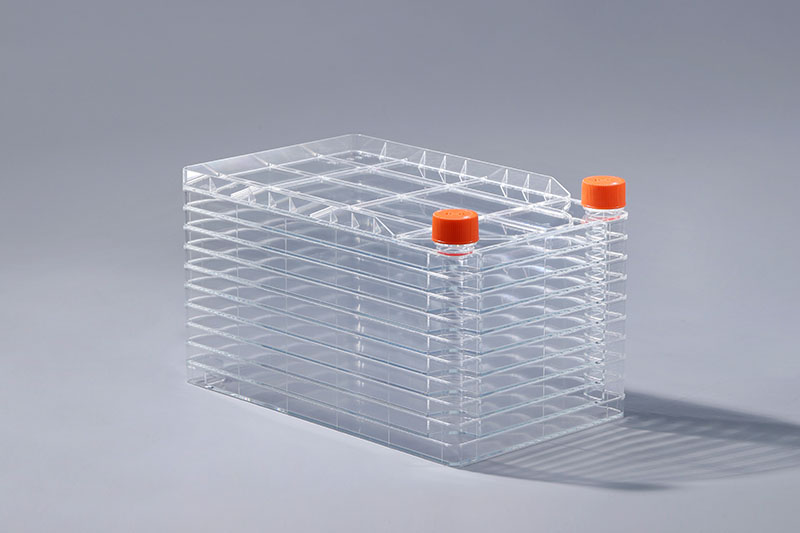पॉलीस्टाइरीन (PS) कच्चे माल से बना एक सेल कल्चर है। यह एक बहु-परत संरचना डिजाइन को अपनाता है। सामान्य विनिर्देशों में 1 परत, 2 परतें, 5 परतें, 10 परतें और 40 परतें शामिल हैं। आवश्यकतानुसार परतों की संख्या को अनुकूलित करें। तो, उपभोग्य सामग्रियों की इस विशेष संरचना के लिए किस उत्पादन प्रक्रिया का उपयोग किया जाता है?सेल फ़ैक्टरी में उपयोग की जाने वाली इंजेक्शन मोल्डिंग प्रक्रिया में मुख्य रूप से निम्नलिखित चरण शामिल हैं:सेल फ़ैक्टरी
1. प्री-मोल्डिंग प्रक्रिया:
प्री-मोल्डिंग प्रक्रिया यह है कि प्लास्टिक सामग्री को एक ग्लास अवस्था से एक चिपचिपा द्रव अवस्था में बदलने के लिए बैरल में गर्म, परिवहन, कॉम्पैक्ट, शीयर, मिश्रित और समरूप किया जाता है, ताकि इंजेक्शन मोल्डिंग आवश्यकताओं को पूरा करें।
2। इंजेक्शन मोल्डिंग प्रक्रिया:
इंजेक्शन भरने के चरण में, स्क्रू स्टोरेज चेंबर में नोजल, मोल्ड रनर और इंजेक्शन सिलेंडर के थ्रस्ट के नीचे गेट के माध्यम से गुहा में पिघला देता है।
3। संपीड़न और संपीड़न प्रक्रिया:
संकोचन के कारण भाग द्वारा खाली की गई मात्रा को भरने के लिए इंजेक्शन मोल्डिंग जारी रखें।
4। कूलिंग और सेटिंग प्रक्रिया:
होल्डिंग प्रेशर खत्म होने के बाद, गेट जम गया है। लेख शीतलन और सेटिंग की अवधि से गुजरता है।
5। इजेक्शन पिकअप प्रक्रिया:
उत्पाद को कुछ समय के लिए ठंडा करने के बाद, इसमें एक निश्चित कठोरता और ताकत होती है। भाग को मोल्ड के इजेक्टर पिन द्वारा इंजेक्शन मोल्ड से बाहर निकाल दिया जाता है। और बाँझपन। यह सुनिश्चित करने के लिए कि कोशिकाएं बेहतर पालन कर सकें, इस उपभोज्य को हाइड्रोफिलिक कारकों को पेश करने के लिए सतह पर टीसी के साथ इलाज करने की भी आवश्यकता है।
After the product has been cooled for a period of time, it has a certain rigidity and strength. The part is ejected from the injection mold by the ejector pin of the mold.
After the production of the cell factory is completed, each layer needs to be assembled, and then it can only leave the factory after various tests such as tightness and sterility. In order to ensure that cells can adhere better, this consumable also needs to be treated with TC on the surface to introduce hydrophilic factors.
The FAI climbed 5.9 percent year-on-year in the first 11 months of 2018, quickening from the 5.7-percent growth in Jan-Oct, the National Bureau of Statistics (NBS) said Friday in an online statement.
The key indicator of investment, dubbed a major growth driver, hit the bottom in August and has since started to rebound steadily.
In the face of emerging economic challenges home and abroad, China has stepped up efforts to stabilize investment, in particular rolling out measures to motivate private investors and channel funds into infrastructure.
Friday's data showed private investment, accounting for more than 60 percent of the total FAI, expanded by a brisk 8.7 percent.
NBS spokesperson Mao Shengyong said funds into weak economic links registered rapid increases as investment in environmental protection and agriculture jumped 42 percent and 12.5 percent respectively, much faster than the average.
In breakdown, investment in high-tech and equipment manufacturing remained vigorous with 16.1-percent and 11.6-percent increases respectively in the first 11 months. Infrastructure investment gained 3.7 percent, staying flat. Investment in property development rose 9.7 percent, also unchanged.
 English
English



















































